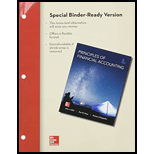
1.
Compute the break-even point in dollar sales for year 2015.
1.
Explanation of Solution
Break-Even Point: It is the point of sales at which entity neither earns a profit nor suffers a loss. It can also be said that the point of sales at which sales value of the entity recovers the entire cost of fixed and variable nature is called break-even point
Given, 20,000 units sold for $750,000, variable costs incurred is $600,000, and fixed costs are $200,000. Contribution margin ratio is 20% (Working note 1).
Compute the break-even point in dollar sales for year 2015:
Therefore, the break-even point in dollar sales for year 2015 is $1,000,000.
Working note1: Compute the contribution margin ratio
| Sales price per unit | $37.50 |
| Variable costs per unit | $30 |
| Contribution margin per unit (B) | $7.50 |
| Contribution margin ratio | 20% |
Table (1)
2.
Compute the predicted break-even point in dollar sales for 2016 assuming the machine is installed and there is no change in the unit selling price.
2.
Explanation of Solution
Break-Even Point: It is the point of sales at which entity neither earns a profit nor suffers a loss. It can also be said that the point of sales at which sales value of the entity recovers the entire cost of fixed and variable nature is called break-even point
Fixed costs are $350,000 (refer working note 2) and contribution margin ratio is 60% (refer working note 3).
Compute the predicted break-even point in dollar sales for 2016:
Therefore, the predicted break-even point in dollar sales for 2016 is $583,333 (rounded off to next dollar).
Working note 2: Compute the predicted fixed costs for 2016.
| Fixed cost in 2015 | $200,000 |
| Add: Increase in the fixed costs | $150,000 |
| Predicted fixed costs for 2016 | $350,000 |
Table (2)
Working note 3: Compute the predicted contribution margin ratio for 2016.
| Predicted sales price per unit (no change in sales price) | $37.50 |
| Predicted variable costs per unit | $15 |
| Predicted contribution margin ratio | 60% |
Table (3)
3.
Prepare a
3.
Explanation of Solution
Prepare a
Contribution margin income statement: It is a kind of income statement which reports the sales, variable costs, contribution margin, fixed costs, and net profit.
Prepare a forecasted contribution margin income statement for 2016:
| Company R | |
| Forecasted Contribution Margin Income Statement | |
| For Year Ended December 31, 2016 | |
| Sales | $750,000 |
| Less: Variable costs | 300,000 |
| Contribution margin | 450,000 |
| Less: Fixed costs | 350,000 |
| Income before income taxes | $100,000 |
Table (4)
4.
Compute the sales level required in both dollars and units to earn $200,000 of target pre-tax income in 2016 with machine installed and no change in unit sale price.
4.
Explanation of Solution
Fixed costs are $350,000 (refer working note 2), target operating revenue is $200,000 and average contribution margin ratio is 60% (refer working note 3).
Required sales in dollars:
Required sales in units:
Selling price per unit is $37.50 and required sales in dollars are $916,667.
Therefore, the sales level required in both dollars and units to earn $200,000 are $916,667 (rounded off to next dollar) and 21,667 units (rounded off to next unit) respectively.
5.
Prepare the forecasted contribution margin income statement that shows the results at the sales level computed in part 4.
5.
Explanation of Solution
Prepare the forecasted contribution margin income statement that shows the results at the sales level computed in part 4:
| Company R | |
| Forecasted Contribution Margin Income Statement | |
| For Year Ended December 31, 2016 | |
| Sales | $916,688 |
| Variable costs | 366,675 |
| Contribution margin | 550,013 |
| Fixed costs (refer working note 2) | 350,000 |
| Income before income taxes | $200,013 |
Table (5)
Therefore, forecasted pre-tax income for the year 2016 is $200,013.
Want to see more full solutions like this?
Chapter 21 Solutions
Principles of Financial Accounting, Chapters 1-17 - With Access (Looseleaf)

 AccountingAccountingISBN:9781337272094Author:WARREN, Carl S., Reeve, James M., Duchac, Jonathan E.Publisher:Cengage Learning,
AccountingAccountingISBN:9781337272094Author:WARREN, Carl S., Reeve, James M., Duchac, Jonathan E.Publisher:Cengage Learning, Accounting Information SystemsAccountingISBN:9781337619202Author:Hall, James A.Publisher:Cengage Learning,
Accounting Information SystemsAccountingISBN:9781337619202Author:Hall, James A.Publisher:Cengage Learning, Horngren's Cost Accounting: A Managerial Emphasis...AccountingISBN:9780134475585Author:Srikant M. Datar, Madhav V. RajanPublisher:PEARSON
Horngren's Cost Accounting: A Managerial Emphasis...AccountingISBN:9780134475585Author:Srikant M. Datar, Madhav V. RajanPublisher:PEARSON Intermediate AccountingAccountingISBN:9781259722660Author:J. David Spiceland, Mark W. Nelson, Wayne M ThomasPublisher:McGraw-Hill Education
Intermediate AccountingAccountingISBN:9781259722660Author:J. David Spiceland, Mark W. Nelson, Wayne M ThomasPublisher:McGraw-Hill Education Financial and Managerial AccountingAccountingISBN:9781259726705Author:John J Wild, Ken W. Shaw, Barbara Chiappetta Fundamental Accounting PrinciplesPublisher:McGraw-Hill Education
Financial and Managerial AccountingAccountingISBN:9781259726705Author:John J Wild, Ken W. Shaw, Barbara Chiappetta Fundamental Accounting PrinciplesPublisher:McGraw-Hill Education





